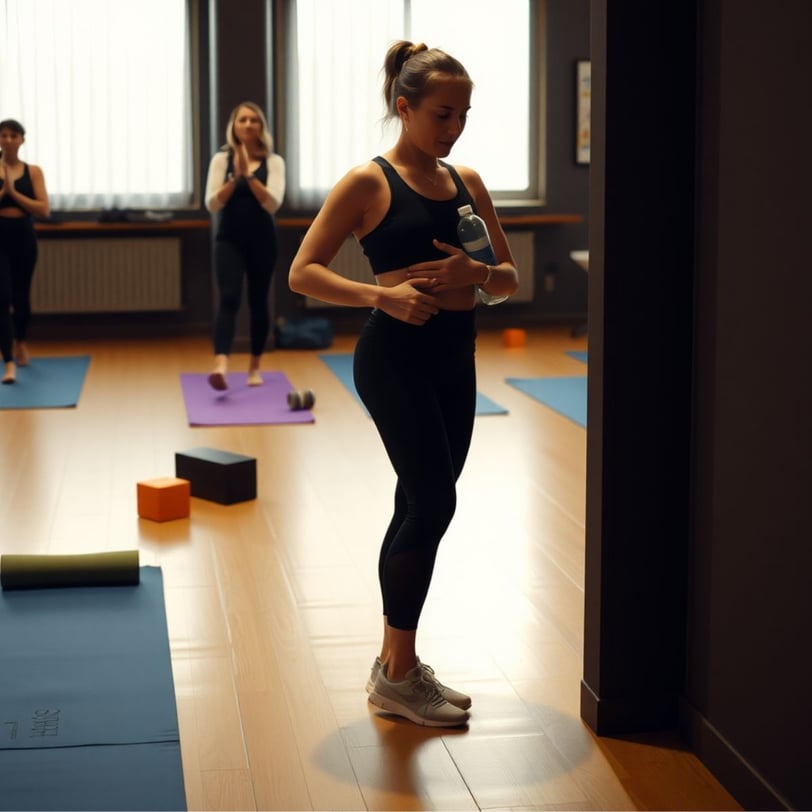
Managing Menopause: Understanding Hormonal Changes and Bladder Control for Incontinence Relief
Understand the link between menopause and bladder control. Learn effective strategies to manage urinary incontinence during this life transition with hormone therapy, lifestyle changes, and Kegel exercises. Take charge of your health today!
INCONTINENCE CARE
Introduction
As a woman navigates through menopause, she may encounter unexpected challenges such as urinary incontinence. This condition can be bothersome but is a common part of the transition into postmenopausal life. It's crucial to grasp how hormonal changes affect your body and what steps you can take to regain control over bladder function. Let's explore the connection between menopause and bladder control, and discuss actionable strategies for managing this common symptom.
Table of Contents


Sarah, mid-50s, craves her morning coffee but dreads the inevitable leak after just one sip. She sighs, remembering how easy it used to be.
Let’s be real—menopause can throw us all for a loop, right? Hot flashes, mood swings, and yes, bladder control issues. It’s one of those things we don’t always talk about, but so many of us face it. As a nurse, I've seen firsthand how frustrating this can be. So, what's really going on with your bladder during menopause, and more importantly, what can you do about it?
Why Does Menopause Mess with Your Bladder?
It all boils down to hormones. Ever heard of estrogen? It's like the superhero of your pelvic health. But during menopause, your body starts producing less of it, and that’s when things can get tricky. Without enough estrogen, your pelvic floor muscles—which help keep everything in place—get weaker. Think of your pelvic floor like a hammock holding up your bladder. If the hammock sags, well, your bladder’s not getting the support it needs.
Here’s what happens when those hormone levels drop:
Weak muscles: Your pelvic floor loses its strength, so keeping control of your bladder gets harder.
Thinner tissues: The walls of your urethra (that tube that helps you pee) get thinner, which makes incontinence more likely.
Irritable bladder: You might feel like you need to pee all the time, even when your bladder isn’t full.
Vaginal dryness: That drop in estrogen can also lead to dryness down there, which doesn’t make things any more comfortable.
This table illustrates how the decline in estrogen levels during menopause impacts various aspects of pelvic floor health, potentially increasing the risk of urinary incontinence and other pelvic floor disorders. It’s important to note that while these changes are common, they are not inevitable. Various management strategies can help maintain pelvic floor health during and after menopause.
What Kind of Incontinence Are We Talking About?
So, what kind of bladder issues might pop up? There are two common types of urinary incontinence during menopause:
Stress Incontinence: Ever sneeze, cough, or laugh a little too hard and suddenly feel a leak? That’s stress incontinence. It's like your bladder’s playing a practical joke on you whenever you’re putting pressure on it—whether you’re exercising or just standing up too fast.
Urge Incontinence: Imagine being out and about, and out of nowhere, you get this overwhelming need to find a bathroom right now. That’s urge incontinence, also known as overactive bladder. Sometimes, the urgency hits so quickly, you might not make it to the bathroom in time.
Recognizing the Symptoms: When Should You Seek Help?
We all know our bodies change during menopause, but how do you know when it’s time to ask for help? While a little bladder leakage or hot flash here and there might seem like just part of the package, you don’t have to just grin and bear it. When these symptoms start messing with your everyday life—interrupting your sleep, making you feel anxious about leaving the house, or impacting your confidence—it’s time to reach out.
But what else should you keep an eye on?
Beyond Bladder Leakage – Other Menopausal Symptoms
Menopause can be a rollercoaster for your body and your mind. Besides bladder issues, you might also notice:
Hot flashes: Those sudden waves of heat that leave you feeling flushed and sweaty.
Night sweats: Waking up drenched in sweat, kicking off the blankets, and still feeling too warm.
Vaginal dryness: That uncomfortable dryness and irritation that can affect intimacy and comfort.
Mood swings: One moment you’re fine, the next you're crying or snapping at someone—emotions can swing wildly.
Sleep disturbances: Whether it’s waking up from night sweats or just not being able to sleep through the night, menopause often messes with your rest.
Here’s the thing—experiencing several of these symptoms at once is totally normal. But that doesn’t mean it’s easy. And beyond the physical stuff, there’s the emotional toll. How many times have you felt frustrated or just over it because your body isn’t cooperating? It's important to remember that these changes don’t just affect your body—they can impact how you feel about yourself, your relationships, and your overall quality of life. So, when do you seek help? When these symptoms start running the show.


During a lively yoga class, Maria, 53, feels a sudden urge and leaks urine. Embarrassed, she quickly excuses herself, wishing she'd known about Kegel exercises sooner.
Effective Management Strategies for Incontinence During Menopause
You don’t have to just accept incontinence as part of your life. There are plenty of ways to take back control, and the good news? Some of them are pretty simple! Here’s a look at a few strategies that can make a real difference.
Lifestyle Modifications: Small Changes, Big Results
You might be surprised at how much of a difference a few tweaks to your daily routine can make. Think of it as giving your body a little extra support during this time of change. Here’s where to start:
Cut back on caffeine and alcohol: Love your morning coffee or that evening glass of wine? Unfortunately, both can irritate your bladder and make incontinence worse. Try scaling back and see how you feel.
Maintain a healthy weight: Carrying extra weight puts more pressure on your bladder. Dropping even a few pounds can help ease that burden and reduce leakage.
Quit smoking: Smoking is a known bladder irritant, not to mention it can cause chronic coughing, which only adds to bladder pressure.
Manage fluid intake: Don’t chug water all at once. Instead, sip smaller amounts throughout the day. And avoid big drinks close to bedtime to cut down on those middle-of-the-night trips to the bathroom.
Kegel Exercises: Strengthen Your Pelvic Floor, Strengthen Your Control
Now, let’s talk about Kegels—your secret weapon against incontinence. These exercises target your pelvic floor muscles, which help keep everything in place down there. It’s like giving your bladder the reinforcement it needs. And the best part? You can do them just about anywhere, anytime (seriously, no one will even know).
Here’s how to do a proper Kegel:
Squeeze your pelvic muscles like you’re trying to stop the flow of urine mid-stream.
Hold for about 5 to 10 seconds (counting in your head helps).
Release slowly, then rest for another 10 to 15 seconds.
Repeat 10 to 15 times, aiming for 3 to 4 sets throughout the day.
Medical Treatments & Therapies
When lifestyle changes and exercises aren’t enough, there are medical treatments that can step in and help you regain control. Let’s take a look at some options.
Hormone Replacement Therapy (HRT): Restoring Hormonal Balance
For some women, Hormone Replacement Therapy (HRT) can be a game-changer. It helps bring back the hormonal balance that menopause throws off, particularly boosting the health of your urethral and vaginal tissues. Think of it as giving your body the hormones it’s missing to restore balance and strength.
There are different forms of HRT you can explore with your doctor, such as:
Creams: Applied directly to the vaginal area to boost estrogen levels locally.
Vaginal rings: A small, flexible ring that releases estrogen steadily over time.
Oral medications: Taken by mouth to help restore hormonal balance throughout your body.
However, not everyone is a candidate for HRT, so it’s important to have a chat with your doctor to see if this option is a good fit for you.
Medications: Targeting Specific Types of Incontinence
In some cases, medication might be the best way to tackle incontinence, especially if you’re dealing with specific types like urge incontinence or stress incontinence. Here are a couple of options you might hear about:
Anticholinergics: These meds help by relaxing your bladder muscle, reducing the frequent, urgent trips to the bathroom.
Alpha-blockers: By relaxing the bladder neck and urethral muscles, these can improve the flow of urine and reduce leakage.
Each of these treatments is aimed at different incontinence issues, so again, it’s all about finding what works best for your body with the guidance of your doctor.
This table summarizes the various forms of Hormone Replacement Therapy (HRT) for managing menopausal symptoms:
Oral Tablets: Systemic relief for hot flashes, night sweats, and vaginal dryness. Higher risk of blood clots and stroke.
Transdermal Patches: Systemic relief with a lower risk of blood clots than oral tablets. Possible skin irritation.
Vaginal Creams: Local relief for vaginal dryness with minimal systemic absorption. May cause vaginal discharge.
Vaginal Rings: Local relief with long-lasting effects. Possible vaginal discomfort or expulsion.
Gels/Sprays: Systemic relief with flexible dosing and lower blood clot risk. May cause skin irritation.
This table provides an overview of medications commonly used to manage incontinence. It details the types of medications, their examples, mechanisms of action, and intended effects:
Anticholinergics: Medications like Oxybutynin and Tolterodine block acetylcholine to reduce bladder contractions, helping to calm an overactive bladder and alleviate urge incontinence.
Alpha-blockers: Drugs such as Tamsulosin and Alfuzosin relax bladder neck muscles and prostate tissue, easing bladder emptying, especially useful for men with urge or overflow incontinence.
Exploring Other Treatment Options
When lifestyle changes, exercises, and medications aren’t cutting it, there are still other options to consider. For more severe cases of incontinence,
Medical Devices & Procedures: When Lifestyle Changes Aren’t Enough
If you’re dealing with frequent or severe leakage, there are several medical devices and procedures designed to help give you more control. Let’s break them down:
Urethral inserts: Think of these as tiny, temporary plugs for your urethra. You insert them before activities that might cause leakage—like exercise—and take them out when you’re done. They work by blocking the flow of urine until you’re ready to go.
Pessaries: A pessary is a small, flexible device that’s inserted into the vagina to support the bladder and reduce pressure on the urethra. It's especially helpful if you have pelvic organ prolapse. Your doctor can fit you for one, and it can be a great option for managing stress incontinence.
Surgical options: For some women, surgery may be the best long-term solution, especially if other treatments haven’t worked. Two common procedures include:
Sling surgery: A sling is placed around your urethra to provide extra support, helping prevent leaks when you cough, sneeze, or move suddenly.
Bladder neck suspension: This procedure lifts and secures the bladder neck and urethra to give them more support and reduce leakage.
These options are more invasive, but they can offer lasting relief when other strategies just aren’t enough. Of course, any medical procedure comes with risks, so it’s important to weigh your options carefully with your healthcare provider.
Seeking Professional Guidance
Navigating menopause and incontinence can feel overwhelming, but you don’t have to do it alone. Finding the right healthcare provider can make all the difference. But who should you see—your gynecologist or a urologist? Let’s break it down.
Finding the Right Healthcare Provider: Gynecologist vs Urologist
When it comes to managing menopause-related symptoms, both gynecologists and urologists can play a role. The key is knowing which expert to turn to, depending on your symptoms.
Consult a gynecologist if you’re dealing with:
Vaginal dryness, urogenital atrophy, or weakened pelvic floor muscles.
Hormone-related issues like low estrogen that could benefit from Hormone Replacement Therapy (HRT).
General menopause-related health concerns or medical treatments.
Consult a urologist if you’re struggling with:
Urinary incontinence or an overactive bladder. They specialize in bladder control issues.
Exploring surgical options or medical devices like urethral inserts or pessaries.
Think of it like this: If your symptoms are tied to hormonal changes or pelvic health, your gynecologist is the go-to. But if your bladder is the main culprit, a urologist can provide more targeted help.


After confiding in her best friend about her bladder leaks, Mary, 57, feels relieved and empowered. Her friend offers support and understanding, reminding her that she's not alone.
Building a Supportive Care Team: Communication Is Key
Don’t be afraid to ask for help. Managing menopause and incontinence doesn’t have to be a solo mission. It’s about building a supportive care team that works together to create a plan tailored to your needs. Whether that’s collaborating with your gynecologist, urologist, or even a physical therapist for pelvic floor exercises, having open communication with your healthcare providers is essential.
Remember, it’s your body, and you deserve the best care. Ask questions, express your concerns, and don’t hesitate to reach out when you need guidance. A strong support team can make a world of difference in not only managing your symptoms but improving your overall quality of life.
Taking Control of Your Bladder Health
Menopause can be tough, but when it comes to bladder health, you’re not powerless. With the right strategies and support, you can manage incontinence and take back control of your body.
Here’s the bottom line:
Lifestyle tweaks matter: Small changes in your daily habits—like cutting back on caffeine or maintaining a healthy weight—can go a long way in reducing leaks.
Kegel exercises are your secret weapon: They help strengthen those pelvic floor muscles and give your bladder the support it needs.
Medical treatments are out there: From HRT to medications, and even surgery, there’s a range of options to explore if lifestyle changes aren’t enough.
Professional guidance is key: Don’t hesitate to reach out to a gynecologist or urologist. They can guide you toward the best treatment plan tailored just for you.
By understanding how menopause affects your bladder and exploring these strategies, you’re already on the path to regaining control. You don’t have to go through this alone—there’s help, support, and plenty of options to help you feel confident and in control again.
Additional Resources for Managing Menopause and Bladder Control
To help you navigate the complexities of menopause and bladder control, here are some key references and resources. These sources offer valuable insights into hormonal changes, symptom management, and treatment options.
1. The Estrogen Connection: Why Hormone Levels Matter for Pelvic Floor Health
Reference: SheCares. “Estrogen Roles and Effects.” SheCares, 2024. SheCares.
Description: Learn how estrogen supports pelvic floor muscles and bladder function. This article explains how the decline in estrogen during menopause affects bladder health and pelvic support.
2. Decline in Estrogen During Menopause and Its Direct Impact
Reference: Pelvic Health Physical Therapy. “Menopause and Pelvic Floor Health: Understanding the Impact.” Pelvic Health Physical Therapy, 2024. Pelvic Health Physical Therapy
Description: This source discusses how decreasing hormone levels lead to weaker pelvic muscles and urinary incontinence during menopause.
3. Common Types of Urinary Incontinence During Menopause
Stress Incontinence
Reference: Healthline. “Menopause and Urinary Incontinence.” Healthline, 2024. Healthline.
Description: Discover what causes stress incontinence and how weakened muscles affect bladder control during activities like coughing or exercising.
Urge Incontinence
Reference: National Association For Continence. “Menopause And Incontinence.” National Association For Continence, 2024. National Association For Continence.
Description: This article explains urge incontinence and how it is linked to an overactive bladder, including frequent, urgent trips to the bathroom.
Mixed, Overflow, and Nocturnal Enuresis
Reference: Balance Menopause. “Urinary Incontinence in Menopause: Are You Ignoring the Symptoms?” Balance Menopause, 2024. Balance Menopause.
Description: Understand the different types of incontinence, including mixed incontinence, overflow incontinence, and bedwetting.
4. Recognizing the Symptoms and When to Seek Help
Common Menopausal Symptoms
Reference: Medical News Today. “What Are the 34 Symptoms of Menopause, and What Helps?” Medical News Today, 2024. Medical News Today.
Description: This source lists common menopausal symptoms and their impacts, providing context for recognizing when you might need professional help.
Emotional Impact of Menopausal Symptoms
Reference: ACOG. “Mood Changes During Perimenopause Are Real. Here’s What to Know.” ACOG, 2024. ACOG.
Description: Explore how mood changes during menopause affect your overall quality of life and emotional well-being.
5. Effective Management Strategies for Incontinence During Menopause
Lifestyle Modifications
Reference: Healthline. “Menopause and Urinary Incontinence.” Healthline, 2024. Healthline.
Description: This article offers practical tips on managing incontinence through lifestyle changes such as diet adjustments and weight management.
Kegel Exercises
Reference: Menopause Network. “Urinary Incontinence.” Menopause Network, 2024. Menopause Network.
Description: Learn how Kegel exercises strengthen pelvic floor muscles to improve bladder control.
6. Medical Treatments and Therapies
Hormone Replacement Therapy (HRT)
Reference: Aeroflow Urology. “Managing Incontinence & Menopause.” Aeroflow Urology, 2024. Aeroflow Urology.
Description: An overview of HRT options including creams, vaginal rings, and oral medications, and how they can help manage menopause-related symptoms.
Reference: NHS. “Types of Hormone Replacement Therapy (HRT).” NHS, 2024. NHS.
Description: This source provides comprehensive information on the different types of HRT available, including the hormones involved, methods of administration, and factors to consider when choosing the right type of HRT.
Reference: NHS Inform. “Hormone Replacement Therapy (HRT).” NHS Inform, 2024. NHS Inform.
Description: This article explains the main types of HRT, their benefits, and how they can help alleviate menopausal symptoms. It also discusses the importance of consulting with a healthcare provider to determine the most suitable HRT option.
Reference: WebMD. “Which Type of Estrogen Hormone Therapy Is Right for You?” WebMD, 2024. WebMD.
Description: This source outlines the various forms of estrogen hormone therapy, including pills, patches, creams, gels, and vaginal rings. It provides detailed information on the pros and cons of each type, helping women make informed decisions about their HRT options.
Medications
Reference: Healthline. “Menopause and Urinary Incontinence.” Healthline, 2024. Healthline.
Description: This article covers various medications used to treat different types of incontinence by relaxing bladder muscles or increasing bladder capacity.
Reference: Mayo Clinic. “Bladder Control: Medications for Urinary Problems.” Mayo Clinic, 2023. Mayo Clinic.
Description: This source provides detailed information on various medications used to treat urinary incontinence, including anticholinergics and alpha-blockers, their mechanisms of action, and their intended effects.
Reference: eMedicineHealth. “Bladder Control Medication: A List of the Best Incontinence Drugs.” eMedicineHealth, 2023. eMedicineHealth.
Description: This source provides a comprehensive list of medications used to treat bladder control issues, including their mechanisms of action and intended effects on bladder control.
7. Exploring Other Treatment Options
Medical Devices and Surgical Options
Reference: National Association For Continence. “Menopause And Incontinence.” National Association For Continence, 2024. National Association For Continence.
Description: Discusses the use of medical devices like pessaries and urethral inserts, as well as surgical options for severe incontinence.
8. Seeking Professional Guidance
Finding the Right Healthcare Provider: Gynecologist vs Urologist
Reference: Healthline. “Menopause and Urinary Incontinence.” Healthline, 2024. Healthline.
Description: Guidance on consulting either a gynecologist or urologist based on your specific symptoms and treatment needs.
Building a Supportive Care Team
Reference: Healthline. “Menopause and Urinary Incontinence.” Healthline, 2024. Healthline.
Description: Emphasizes the importance of collaborating with a supportive care team to effectively manage incontinence and menopause symptoms.
Years after struggling with bladder leaks, Emily, 65, finally feels confident and empowered. She embraces her menopause journey with grace and resilience, knowing that she has the tools to manage her symptoms effectively.


FAQ:
Why does menopause cause bladder control issues?
Menopause leads to a drop in estrogen levels, which affects the health of your pelvic floor muscles, bladder, and urethral tissues. Weaker muscles and thinner tissues make it harder to control your bladder, leading to symptoms like incontinence or frequent urination.
Can lifestyle changes really help with incontinence during menopause?
Yes, absolutely! Simple changes like reducing caffeine and alcohol intake, maintaining a healthy weight, and managing fluid consumption can have a big impact on your bladder control. These adjustments support your overall bladder health and reduce the severity of symptoms.
How do I know if I’m doing Kegel exercises correctly?
To perform Kegels, imagine you’re trying to stop the flow of urine. Squeeze those muscles for about 5-10 seconds, then release. If you’re unsure, a pelvic floor specialist or your healthcare provider can help you learn the proper technique.
When should I see a doctor about my bladder issues?
If bladder control issues start interfering with your daily life—like causing anxiety, disrupting sleep, or leading to frequent leaks—it’s time to consult a healthcare provider. A gynecologist or urologist can help identify the best treatment for you.
Are there non-surgical treatments for incontinence?
Yes! Aside from lifestyle changes and Kegel exercises, there are medications that can help reduce urgency or improve bladder control. Hormone Replacement Therapy (HRT) is another option
Is surgery the only option for severe incontinence?
Surgery is usually considered when other treatments haven’t worked. However, procedures like sling surgery or bladder neck suspension can provide lasting relief for severe incontinence. Discuss with your doctor to weigh the risks and benefits before making a decision.
Overcoming Bladder Control Challenges: You're Not Alone
Menopause brings its challenges, but managing bladder control doesn’t have to be one of them. There are effective solutions available, and you don’t have to face it alone. Reach out to your healthcare provider for personalized guidance, and don’t let incontinence hold you back from living your life to the fullest. Have tips or experiences to share? Drop a comment below and help others in the community, and don’t forget to share this article with anyone who might find it helpful!
Related Article
More for you



